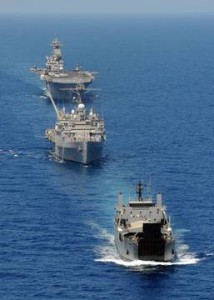Chris Albon and I have an article up at The Atlantic to discuss the challenges of getting noncombatants out of Korea. Aside from my concern that our NEO evacuation plans (and our misguided effort to “normalize” Korean tours) are unready, under-resourced and poorly planned, I think the entire region needs to do some serious thinking about managing a Korean conflict (a conflict that, if it comes, will reach far south of the DMZ).
In the article, I had a chance to bring up something that has intrigued me for some time–the potential utility of China’s amphibious fleet:
Countries around the globe with civilians or officials in South Korea would look to the U.S. first for evacuation support. But with a war to fight; wounded, contaminated, or infectious casualties to deal with; and amphibious lift resources at a premium, there would not be enough space for all who wish to leave.
Ironically, China, for all it has done to enable the present Korean crisis, may pose the best, last hope for many evacuees. With Korean, Japanese and American transport ships likely to be fully committed to the military conflict, the only other untapped Asian source of heavy amphibious sealift is China. Though often dismissed by military analysts as little more than a garnish for a “million-man swim” to Taiwan, China’s amphibious assault fleet could rescue many stranded non-combatants. China’s massive civilian fleet offers another possible resource. Plenty of Chinese ships will be available, able to respond if allowed to enter South Korean waters.
Over the course of the past month, the Philippines, one of many countries that lack the resources to carry out a timely evacuation of their Korean-based ex-patriots, has been debating how it could meet the challenge of transporting some 60,000 Filipino temporary workers out of a Korean crisis. For cases like this, where evacuation support will fall far short of demand, China’s armada of over fifty relatively modern medium-range amphibious vessels, capable of moving over 20,000 people in a single, albeit uncomfortable and slow voyage, would be an enormous boon.
A Chinese rescue fleet poses a political, operational and symbolic headache for South Korea, the U.S., and Japan. Chinese assistance with a Korean evacuation would be an enormous political coup for Beijing. Even modest Chinese support during a high-profile humanitarian emergency could do a lot to blunt wider Asian concerns over China’s naval expansion and territorial ambitions. And in the case of the Philippines, a timely humanitarian gesture by the People’s Liberation Army’s Navy would strengthen Chinese influence there and maybe even reconcile a festering territorial dispute over their contested South China Sea islets – to China’s favor. But the defenders of South Korea would not have any other choice than to ask for China’s assistance. No other help is available.
Chinese participation in a Korean contingency is the kind of scenario that makes U.S. policy makers in the region wince. But such are the ugly compromises that must be made if the U.S. and other countries fail to plan now, while there is still time to prepare, for how to get potentially-threatened nationals out before the Korean peninsula lurches over the precipice.
We will be talking a lot more about this in the coming months. But I’m fascinated just how we blithely dismiss China’s simple amphibs. They’re little more than old-school LSTs. We used them to cross the Pacific. We took a handful of old, broken-down LSTs and landed at Inchon. By so blithely dismissing China’s LST equivalents, I fear we have forgotten our own history. Just because we wouldn’t do it that way now does not mean that other countries will follow our lead.
The old LST worked fine in the ’50s. There’s little reason updated equivalents won’t do the same today. It won’t be cozy or fun, but, then again, some countries may put less of a premium on sailor comfort.
And that may come back and surprise us all.

